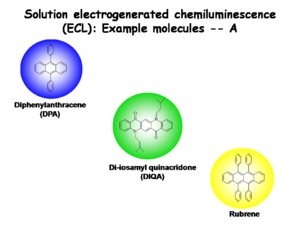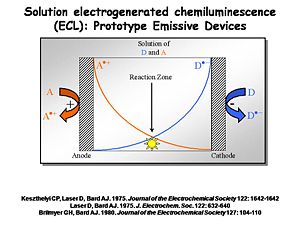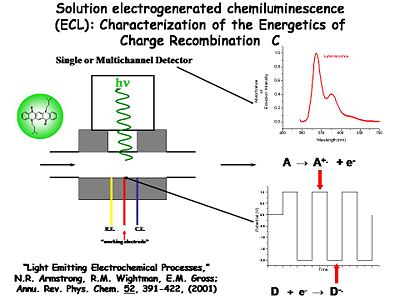Difference between revisions of "The OLED Test Cell"
Cmditradmin (talk | contribs) |
Cmditradmin (talk | contribs) |
||
| Line 13: | Line 13: | ||
*You need molecules that have long lifetimes for the both the cation radical and the anion radical space so that means some careful purification has to be done. | *You need molecules that have long lifetimes for the both the cation radical and the anion radical space so that means some careful purification has to be done. | ||
*One of these electrodes has to allow you get light out of the system otherwise there is no display. | *One of these electrodes has to allow you get light out of the system otherwise there is no display. | ||
[[image:OLED2_energetics.JPG|400px]] | [[image:OLED2_energetics.JPG|400px]]<br clear="all"> | ||
The solution ECL experiment is simple to construct – a flowing solution containing both D and A is passed in front of a Pt or Au microelectrode surrounded by a reference and counter electrode in a small solution cavity. The potential of the Au or Pt electrode is alternatively pulsed positive (to generate A+.) and negative (to generate D-.) with a frequency typically up to a few KHz. The products of these heterogeneous electron transfer reactions diffuse away from the electrode, where they are likely to encounter each other (on the time scale of microseconds). The resultant recombination reactions generate the emissive state of one pair of these molecules, the light from that emission event is coupled out to a multi-channel detector spectrophotometer and the emission spectrum recorded. | The solution ECL experiment is simple to construct – a flowing solution containing both D and A is passed in front of a Pt or Au microelectrode surrounded by a reference and counter electrode in a small solution cavity. The potential of the Au or Pt electrode is alternatively pulsed positive (to generate A+.) and negative (to generate D-.) with a frequency typically up to a few KHz. The products of these heterogeneous electron transfer reactions diffuse away from the electrode, where they are likely to encounter each other (on the time scale of microseconds). The resultant recombination reactions generate the emissive state of one pair of these molecules, the light from that emission event is coupled out to a multi-channel detector spectrophotometer and the emission spectrum recorded. | ||
Revision as of 10:52, 12 March 2009
Solution electrogenerated chemiluminescence example molecules
We are going to focus on Diphenylanthracene since so much is known about its electrogenerated chemiluminescence and it has strong literature. All these molecules have the same common components. They have absorbance spectra in solution with a vibronic fine structure, they have small Stokes shifts, and luminescence spectra with corresponding vibronic fine structure.
Prototype Emissive Devices
The interest in ECL was so strong that in the 1970s several investigators decided this might be a way to create light in a usable way. An electrochemical cell can be built with two electrodes separated by a narrow space filled with solution in which both A an D are located. A and D could be two different chemicals or one in the case of diphenylanthracene (DPA). You independently control the potential of the two electrodes using a potentiostat so that at the anode you generate the cation radical form of A at a diffusion-controlled rate. At the cathode you generate the radical anion form of the species D at a diffusion controlled rate. These molecules will diffuse away from the electrode at which they are produced into the solution volume between the electrodes. Where they meet at the center of the device the electron transfer reaction between the donor and the acceptor will occur and there will be an emissive state. This is heroic science because it’s very hard to produce.
- Layers must be very thin so they can be filled electrochemically in a very short period of time
- The possibility of interaction for the two molecules to be high.
- You need molecules that have long lifetimes for the both the cation radical and the anion radical space so that means some careful purification has to be done.
- One of these electrodes has to allow you get light out of the system otherwise there is no display.
The solution ECL experiment is simple to construct – a flowing solution containing both D and A is passed in front of a Pt or Au microelectrode surrounded by a reference and counter electrode in a small solution cavity. The potential of the Au or Pt electrode is alternatively pulsed positive (to generate A+.) and negative (to generate D-.) with a frequency typically up to a few KHz. The products of these heterogeneous electron transfer reactions diffuse away from the electrode, where they are likely to encounter each other (on the time scale of microseconds). The resultant recombination reactions generate the emissive state of one pair of these molecules, the light from that emission event is coupled out to a multi-channel detector spectrophotometer and the emission spectrum recorded.
Consider the non- display application which was used to look at the dynamics of electron transfer and light emission. This system was used by Neal Armstrong and Mark Wightman and the UNC , a group that had the world’s expertise in this area at the time. This involves a very small cavity with solvent in it. A window in the center positioned opposite a photomultiplier tube or some photodetector.
There are three electrodes. The center one is the working electrode, typically a small microband or microdisc electrode with a diameter of 5-50 microns. The counter and reference electrodes are poised on either side. The solution cavity is able to flow in fresh solution periodically, this is important.
Characterization of the Energetics of Charge Recombination
You modulate the potential of the working electrode with respect to the reference electrode between two extremes. At one extreme it generates the cation radical of A and at the other extreme it generates the anion radical of D. You cycle the potential of the these two extremes at frequencies of a kilohertz or more. By flipping the potential back and forth so fast you generate both species in the diffusion layer volume next to the electrode surface where they can interact and give off a photon which is counted with the detector. Wightman was able to monitor single photons and single electron transfer events with this system. The results can be further studied with spectroscopy of the light emitting process to confirm that the results match or differ from what you see in a device.
Cross Reactions
This an example of a voltamogram of the obtained at the micro electrode for DPA in a low dielectric constant solvent. When you scan negatively you the microelectrode response for a one electron reduction of the DPA to its radical anion. When you scan positively this give the one electron oxidation of the DPA to its radical cation form. The different between the midpoint potentials are called the halfway potentials. This give an indication of the energy difference of the two forms and a clue to the amount of excess free energy that will be generated by the redox reaction that follows. In this reaction there is more than 3 electron volts of excess free energy. DPA exciting state easily forms and re-emits with a peak wavelength of about 450 nm. If you calculate the energy this is 3-3.1 eV. So the electo chemical event generated more than enough excess free energy to create the excited singlet state of DPA.
Now you compare the yield the DPA excited states as you systematically change the redox event that occurs. First generating the DPA anion with one pulse and the DPA cation with another pulse the ΔE_(½ ) is about 3.33 electron volts. This forms the excited singlet state known as the “S-route” .
Next you put a second species Methoxybenzophonone which reduced at a slightly less negative potential, generating its anion radical at 3.24 electron volts. When you do spectroscopy you see that you are still forming the DPA exciting state and its slightly less efficient. It is still an S-route process.
Using Benzophonone it has a less negative potential with an excess free energy of 3.15 volts and still is an S-route.
Marcus Theory for Electron Transfer
The Marcus theory for electron transfer provides some of the needed predictability to describe both probability of light emission from an ECL cross reaction, and the probability of light emission in an OLED at the interface between two dissimilar charge transporting layers.
All electron transfer reactions proceed through a transition state whose energy is defined primarily by the “reorganization energy” (λT). This energy can be divided into an “internal reorganization” energy (λi -- the energy needed to reorganize the internal molecular environment in going from the initial to the final state), and the “external reorganization energy (λo – the energy needed to reorganize the solvent or condensed phase environment surrounding the molecule in proceeding from the initial to the final state).
In general as the excess Gibbs free energy (ΔE α ΔG) in the system is increased (Points a, b, c) so that ΔE (ΔG) is close to or exceeds λT = λi + λo in magnitude, the reaction rate accelerates exponentially. For light-emitting electrochemical processes this reaction rate enhancement leads directly to greater production of emissive states, i.e. the output of the ECL process is controlled by controlling the difference in reduction and oxidation potentials of the two reacting components.
This provides some guidance in the design of two-layer OLEDs (see below), where it is clear that you want to maximize the excess free energy in the critical charge recombination process.
You go from a situation where you maximized the free energy at point C. Then by changing the identity of the two pairs of the redox reaction you go to less free energy at point B and then finally point A. You still generate the excited state but with lower overall rate.
The rate is proportional to the number of photons you get out of the experiment. This gives an underlying principal for the design of OLED systems. The idea is maximize the free energy and minimize the reorganization energies for those redox events. Maximize the rate of electron transfer and therefore maximize the rate of light output. You want to me at position C rather position A in the design of the systems.
Unfortunately the design is never that simple.
- The DPA+ + BP- system is results in point A.
- The DPA+ + MOPA- puts us at point B
- The DPA+ + DPA- system is results in point C.
You have changed which species gets reduced and as a consequence changed the excess free energy in the redox reaction. It is possible to create an excess free energy which exceeds the reorganization energy (point d) in which case you enter the “inverted region” and reaction rate decreases. A few examples of this phenomenon have been observed in solutions and glasses, but it has not been, to date, reported in OLEDs.
It would be possible to go too far and get into what’s called “Marcus inverted region” where the excess free energy larger by far than the reorganization energy. In this case you might see the rate of reaction come down. To date we have not seen examples of this in OLEDs. It may have occurred but it difficult to prove. It’s really a question if the excess free energy is much less than the reorganization energy, comparable or greater than the reorganization energy.


